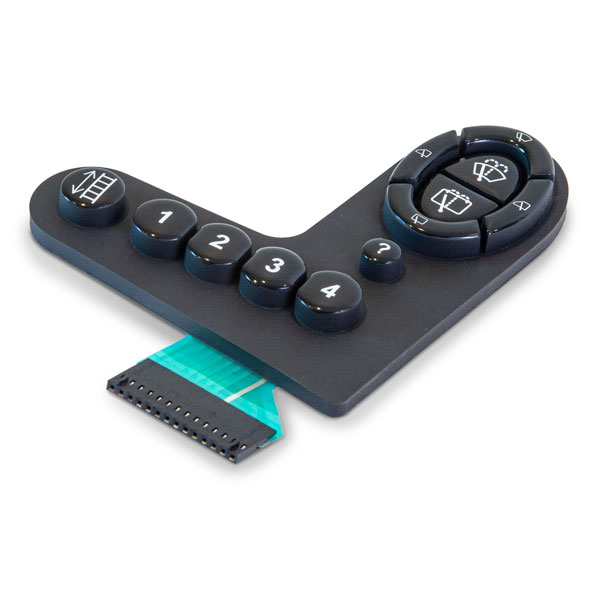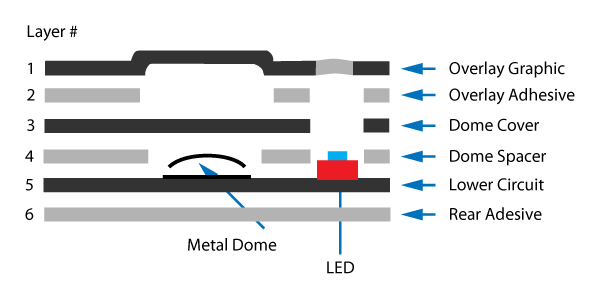Everything About Membrane Switch: A Comprehensive Overview for Beginners
Membrane buttons are essential parts in contemporary electronics, offering an unique user interface for user communication - membrane switch. Their layered building, including overlays and conductive traces, gives performance and toughness. Unlike typical mechanical switches, membrane layer switches present a sleek style and customizable choices. Recognizing their vital functions and advantages can transform item layout. The ins and outs of their application and layout considerations call for further expedition.
What Is a Membrane Switch?
A membrane layer button is a sort of electric switch that includes a versatile membrane layered over a published motherboard. This design permits a smooth and small interface, commonly utilized in numerous digital tools. Membrane switches are generally found in consumer home appliances, clinical devices, and industrial equipment as a result of their durability and resistance to environmental factors.The building typically includes multiple layers, such as graphic overlays and adhesive backing, which give responsive responses and shield the wiring below. The procedure of a membrane layer switch is initiated when pressure is put on the surface, completing an electrical circuit.These buttons are valued for their convenience, enabling custom layouts and published graphics that cater to particular individual interfaces. Their low-profile nature reduces area demands, making them suitable for applications where standard switches may not fit. In general, membrane layer switches offer a visual and functional service for modern-day digital gadgets.
Secret Components of Membrane Layer Switches
Membrane layer changes comprise numerous vital parts that add to their functionality and efficiency. The top layer, understood as the overlay, offers the interface and is often published with signs or graphics. Beneath the overlay exists a spacer layer, which separates the conductive aspects and protects against unintended activation. The next crucial component is the visuals layer, which improves looks and guarantees the durability of the design.Conductive traces, commonly made from products like silver or carbon, are published on the circuit layer. When stress is used to the overlay, these traces enter contact, finishing the circuit. Furthermore, a backing layer uses structural support and can be made from products such as polyester or polycarbonate. Together, these components develop a trustworthy, easy to use user interface suitable for numerous applications, from home devices to industrial devices. Comprehending these aspects is essential for any individual curious about membrane switch modern technology.
How Membrane Layer Switches Over Work
Understanding how membrane layer switches function is crucial for appreciating their prevalent usage in various devices. A membrane switch operates with a collection of layers, including a visuals overlay, spacer, and a circuit layer. When pressure is related to the overlay, it compresses the spacer layer, enabling the circuit layer to make get in touch with and finish an electric circuit. This activity sends a signal to the gadget, triggering a response, such as activating a light or triggering a function.Membrane changes can be developed with numerous features, including tactile feedback, backlighting, and custom graphics, improving individual communication. Their building and construction permits for a covered design, safeguarding the internal elements from dust, wetness, and contaminants. This sturdiness makes them appropriate for varied applications, from customer electronic devices to commercial equipment. Overall, the simplicity and performance of membrane layer switches over add to their appeal in modern-day innovation.
Benefits of Membrane Layer Changes Over Mechanical Buttons
While mechanical switches have actually long been a staple in several devices, membrane switches over deal unique advantages that make them progressively appealing. One significant benefit is their slim account, enabling even more compact designs and better versatility in product development. In addition, membrane layer changes function an uniform surface area, which improves aesthetic allure and simplifies cleaning, making them ideal for atmospheres where hygiene is critical.Another benefit is their resistance to dust and moisture. Unlike mechanical buttons, which can be jeopardized by ecological aspects, membrane buttons supply a closed interface that shields against contaminants - membrane switch. Membrane buttons generally have a longer life-span due to fewer relocating parts, resulting in improved durability and reliability.Cost-effectiveness is likewise a remarkable benefit, as membrane buttons can be produced in bulk with reduced manufacturing expenses. These variables combine to position membrane layer buttons as a useful choice to traditional mechanical choices in numerous applications
Common Applications of Membrane Layer Switches Over
Membrane switches are commonly made use of in various markets, specifically in consumer electronics and commercial control board. In customer devices, they supply a streamlined, user-friendly interface, while in commercial setups, they boost sturdiness and capability. Understanding these applications highlights the adaptability and usefulness of membrane switches in contemporary innovation.
Customer Electronic Devices Instruments
As customer electronics remain to advance, membrane switches have become a popular option for a range of tools as a result of their versatility and sleek style. These switches are frequently discovered in smart devices, tablet computers, and remote controls, where space is limited and looks issue. Their low account and personalized layouts enable makers to produce easy to use interfaces that enhance the overall customer experience. In addition, membrane switches are usually made use of in home appliances such as microwaves and coffee machine, offering user-friendly control alternatives while standing up why not try these out to wetness and dust. The toughness and dependability of membrane switches make them ideal for daily consumer items, guaranteeing longevity and regular efficiency. Overall, their assimilation in customer electronics mirrors a blend of capability and contemporary design.
Industrial Control Panels
The applications of membrane layer changes extend past consumer electronic devices, locating considerable use in industrial control board. These switches are favored for their longevity and resistance to rough atmospheres, making them perfect for manufacturing and procedure control settings. They give a trusted interface for drivers to control equipment, monitor procedures, and readjust settings. Membrane layer switches can be personalized to suit certain functional needs, including features like backlighting and tactile feedback, boosting individual experience. Their inconspicuous design enables for integration into different tools, while their ability to hold up against spills, dust, and severe temperatures warranties longevity. Overall, membrane layer buttons add to risk-free and reliable procedure in industrial applications, demonstrating their adaptability and performance sought after atmospheres.
Factors To Consider for Creating Membrane Layer Switches
When developing membrane buttons, choosing the ideal products is vital to guarantee toughness and capability. In addition, recognizing layer configuration techniques can greatly affect the switch's performance and user experience. These considerations play an important role in creating reputable and efficient membrane switch designs.
Product Option Relevance
Product option plays a crucial duty in the layout and capability of membrane layer switches. The chosen products straight impact the switch's sturdiness, tactile reaction, and overall visual. Trick factors to consider consist of the substrate, which should offer structural honesty while enabling versatility, and the graphic overlay, which requires to be immune to wear and ecological aspects. Conductive products ought to guarantee reputable electrical efficiency, while adhesives have to offer solid bonding without jeopardizing the switch's procedure. Furthermore, compatibility with manufacturing procedures and end-user atmospheres is vital; products should endure differing temperatures, moisture degrees, and chemical exposure. Inevitably, suitable product selection not just improves the membrane layer switch's efficiency however additionally adds to its longevity and individual complete satisfaction, making it a vital aspect of the style procedure.

Layer Setup Strategies

Often Asked Questions
How Much Time Do Membrane Changes Typically Last?
Membrane buttons generally have a life expectancy of 1 to 5 million cycles, relying on usage and environmental problems. Factors such as design high quality and operating regularity greatly influence their longevity and overall performance long life.

Can Membrane Switches Over Be Custom-made for Certain Designs?
Membrane layer buttons can certainly be customized to suit certain designs, enabling varied shapes, shades, and performances. This flexibility enables suppliers to tailor these buttons to satisfy distinct visual and operational requirements properly.
What Materials Are Used in Membrane Layer Switch Building?
Membrane layer switches are commonly built making use of materials such as polyester, polycarbonate, and sticky layers. These products offer longevity, versatility, and resistance to environmental variables, ensuring the switches work effectively in various applications and conditions.
Are Membrane Layer Switches Over Resistant or water resistant to Wetness?
Membrane layer buttons can be made to be moisture-resistant, utilizing specialized finishings and products. Nonetheless, their waterproof capabilities depend on construction quality and particular applications, making it necessary to analyze needs for ideal efficiency in numerous settings.
How Are Membrane Layer Switches Over Fixed if Damaged?
Repairing damaged membrane layer changes normally includes replacing the affected layer or circuit. Technicians might additionally apply conductive adhesive or make use of specialized fixing sets, making sure functionality is restored without full substitute of the entire button setting up. Unlike conventional mechanical switches, membrane layer switches present a streamlined design and personalized alternatives. A membrane button is a kind of electric switch that is composed of a versatile membrane layered over a published circuit board. The operation of a membrane layer switch is find out here launched when pressure is used to the surface, completing an electric circuit.These switches are valued for their convenience, making it possible for custom designs and published graphics that provide to details individual interfaces. While mechanical buttons have long been a staple in many gadgets, membrane layer changes deal unique benefits that make them progressively appealing. Membrane layer switches typically have a longer life expectancy due to fewer moving components, resulting in enhanced longevity and reliability.Cost-effectiveness is likewise a notable benefit, as membrane layer switches can be created in mass with lower production prices.